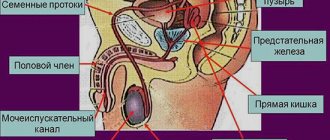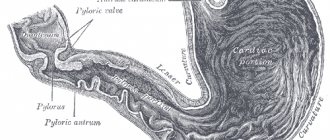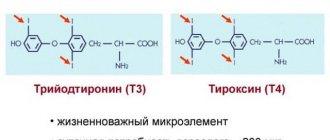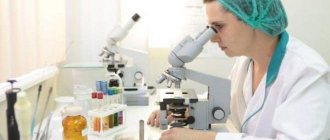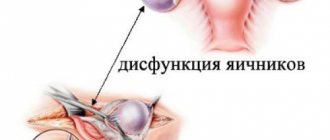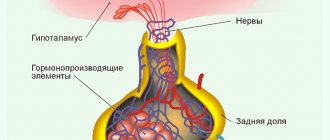Hormonal studies: transcript
(in the process of filling out the norms)
Enter your analysis data in the appropriate fields of the table. After entering the data and moving to the next field, you will see an estimate of the norm of your parameter. By clicking on this assessment, you can familiarize yourself with the possible reasons for deviations from the norms.
Important Notes:
- All information presented on our website is given for informational and reference purposes and is not intended to be used as a guide to the treatment and diagnosis of diseases!
- When entering your age, please adhere to the following gradation:
- Infants:
1-31 days - enter the number of days from 1 to 31 - Children under one year:
- 1-12 months. — enter the number of months from 1 to 12 - Children and adults:
from 1 year - enter the number of full years from 1 to 110
Enter your personal information
| Select gender: | Man Woman | ||||
| Please indicate your age: | |||||
| Specify the phase of the cycle: | |||||
Enter your analysis results
| Indicators | Norm | Your meaning | Evaluation and decoding |
| 1 | 17 KS in urine | ||
| 2 | 17-OH - hydroxyprogesterone | ||
| 3 | ACTH (adrenocorticotropic hormone) | ||
| 4 | Aldosterone | ||
| 5 | Androstenedione | ||
| 6 | Anti-Mullerian hormone (AMH) | ||
| 7 | AFP (alpha fetoprotein) | ||
| 8 | beta-Cross Laps | ||
| 9 | beta-hCG (beta-chorionic gonadotropin) | ||
| 10 | beta hCG free | ||
| 11 | Gastrin | ||
| 12 | Histamine | ||
| 13 | SHBG (sex hormone binding globulin) | ||
| 14 | DEA-S (dehydroepiandrosterone sulfate) | ||
| 15 | DEA-S (dehydroepiandrosterone sulfate) (urine) | ||
| 16 | Dihydrotestosterone | ||
| 17 | Inhibin A | ||
| 18 | Inhibin B | ||
| 19 | Insulin | ||
| 20 | Calcitonin | ||
| 21 | Cortisol (blood) | ||
| 22 | Free cortisol (daily urine) | ||
| 23 | Cortisol (saliva) | ||
| 24 | Cortisol (daily urine) | ||
| 25 | LH (luteinizing hormone) | ||
| 26 | Leptin | ||
| 27 | Osteocalcin | ||
| 28 | P1NP (Bone matrix formation marker) | ||
| 29 | PAP-A protein | ||
| 30 | Parathyroid hormone | ||
| 31 | Placental lactogen | ||
| 32 | Progesterone | ||
| 33 | Proinsulin | ||
| 34 | Prolactin | ||
| 35 | Renin + Angiotensin 1 | ||
| 36 | Serotonin | ||
| 37 | C-peptide | ||
| 38 | STH (somatotropic hormone) | ||
| 39 | Somatomedin-S | ||
| 40 | T3 general (triiodothyronine) | ||
| 41 | T3 St. | ||
| 42 | T4 general (thyroxine) | ||
| 43 | T4 St. | ||
| 44 | Testosterone | ||
| 45 | Testosterone free | ||
| 46 | Thyroglobulin | ||
| 47 | TSH (thyrotropin) | ||
| 48 | T-Uptake | ||
| 49 | FSH (follicle stimulating hormone) | ||
| 50 | Estradiol | ||
| 51 | Estriol St. | ||
| 52 | DPID (deoxypyridinoline) |
** The information and price list posted on the website are not a public offer.
source
general description
The only way to accurately diagnose serious diseases, which are important to identify in the early stages, then treatment will be effective.
The content of hormones in the blood is low, especially when compared with those for other plasma elements, but it is this series of biologically active substances that is involved in almost all processes critical to organisms. Hormonal norms are not a stationary value and depend on both a person’s gender and his age.
Why is estradiol needed?
Estradiol is the main and most active hormone of the female reproductive system. Secretion occurs in the ovaries, a small part is produced by the adrenal cortex. The production of estradiol is influenced by other female hormones - FSH, LH, prolactin.
The functioning of a woman’s reproductive system depends on the amount of estradiol and the activity of its synthesis. The hormone helps prepare the lining of the uterus for the attachment of a fertilized egg.
Estradiol produced by the placenta is responsible for the normal course of pregnancy, accelerates blood circulation in the uterine vessels, and increases the rate of blood clotting.
For ovulation to occur, a certain amount of estradiol must be produced in the correct ratio to testosterone levels.
The concentration of the substance in the blood is constantly changing: the peak is observed between 3 and 6 pm, the minimum values are observed between midnight and two am.
READ What is the normal range of leukocytes in the blood?
In addition, estradiol levels differ in different phases of the menstrual cycle. From the moment the cycle begins, the concentration of the hormone slowly increases and reaches its maximum value at the end of the follicular phase. After ovulation, the level gradually decreases until the end of the luteal phase.
| Phase of the menstrual cycle | Normal values (pmol/l) |
| Follicular phase | 68 – 1269 |
| Ovulatory peak | 131 – 1655 |
| Luteal phase | 91 – 861 |
| Postmenopause | < 73 |
During pregnancy, the level of estradiol systematically increases, the maximum is observed at the end of the third trimester and before childbirth; after the birth of the child, the content of the hormone in the blood gradually returns to normal values.
| Gestational age in weeks | Normal values, pg/ml |
| 9 – 12 | 1020 – 2200 |
| 13 – 16 | 2010 – 4300 |
| 17 – 20 | 3200 – 7800 |
| 21 – 24 | 5100 – 11400 |
| 25 – 28 | 7200 – 14800 |
| 29 – 32 | 7800 – 19200 |
| 33 – 36 | 9300 – 22500 |
| 37-38 | 12200 – 23600 |
| 39-40 | 8200 – 26700 |
An increase in estradiol levels is caused by pathologies of the ovaries, thyroid gland and obesity.
Thyroid hormone test
- TSH. This hormone from the pituitary gland directly affects the thyroid gland and ensures complete circulation of other elements. The norm for a healthy person is from 0.4 to 4 mU/l. Elevated values indicate adrenal insufficiency, severe non-thyroid pathology, resistance to such hormones, neuropsychic agitation or drug use, in particular morphine. A reduced value means increased cortisol levels, thyrotoxicosis, excessive hormone therapy.
- T3 in free form . Provides metabolic activity and has feedback on the work of the pituitary gland. Normal values are from 2.6 to 5.7 pmol/l. Elevated values – peripheral vascular resistance syndrome, hormonal toxicosis or hyperthyroidism, taking methadone, amphetamine. Reduced value - peripheral vascular resistance syndrome, renal failure, disalbuminemic hyperthyroxinemia, fasting, taking iodine-containing drugs, dexamethasone, coumarin, phenytoin, artificial thyrotoxicosis, as well as a physiological decrease in the level in the summer.
- T3 general . Thyroid hormone in the serum state, responsible for the peripheral functioning of the glands. Normal values are from 1.3 to 2.7 nmol/l. An increase in the indicator indicates pregnancy, HIV infection, hepatitis, porphyria, hyperproteinemia, taking tamoxifen, oral contraceptives, amiodarone, amphetamine, and estrogens. Decreased – acromegaly, TSH deficiency, gastrointestinal, liver and kidney diseases, fasting, hemolysis, somatic pathologies, taking testosterone, anabolic steroids, caffeine.
- T4 is free . The main thyroid hormone is responsible for the functioning of transport proteins and maintains their balance in the body. The norm for a healthy person is from ten to 22 pmol/l. Elevated values indicate lipemia, mental or somatic diseases, adrenal insufficiency, taking aspirin, amiodarone, furosemide, or a hereditary increase in TSH. Reduced values – intense physical activity, pregnancy, fasting, autoantibodies with thyroid hormones, taking methadone, salicylates, triiodothyronine, rifampicin.
- T4 general . One of the main thyroid hormones. Normal values are from 58 to 161 nmol/l. An increase indicates obesity, pregnancy, acute hepatitis, intermittent porphyria, HIV infection in the inactive phase, hyperbilirubinemia, taking contraceptives, tamoxifen, heparin, thyroid drugs. Reduction - physical activity, fasting, acromegaly, congenital TSH deficiency, somatic pathologies, gastrointestinal and kidney diseases, taking testosterone, liothyronine, diphenyl, salicylates, anabolic steroids.
- TSG . This glycoprotein from the polypeptide chain is considered the third main binding carrier protein and functional element of the thyroid gland. Normal values are from 259 to 573.5 nmol/l. Elevated values are diagnosed with hyperproteinemia, pregnancy, hepatitis in the acute phase. A decrease indicates somatic pathology, ovarian hypofunction, high levels of catabolism, acromegaly, and congenital hormone deficiency.
- Antibodies to thyroglobulin . They are a useful indicator for identifying a number of problems in the body, especially after surgery. Normal values for this indicator are up to 40 IU/ml. An excess indicates perciotic anemia, Graves' disease, idiopathic myxedema, Hashimoto's thyroiditis, thyroid carcinoma, subacute thyroiditis, and other chromosomal and autoimmune problems.
- Antibodies to thyroid peroxidase . Indicator of resistance to a known enzyme. Its above-normal values indicate autoimmune diseases of the thyroid gland. The normal value of the parameter is up to 35 IU/ml.
- Thyroglobulin . The hormone, consisting of 2 subunits, is produced exclusively by the thyroid gland and is analyzed as a marker of various neoplasms, as well as a kind of “monitor” of the condition of a patient with a removed gland or a person undergoing radioactive iodine therapy. The norm is from 1.7 to 56 ng/ml. A decrease in the indicator indicates a deficiency in the productive function of the thyroid gland in relation to this hormone in hypothyroidism. An increase indicates a benign adenoma, thyrotoxicosis, subacute thyroiditis, as well as primary manifestations of thyroid cancer.
Thyroid examination
Iodine-containing hormones generated by the thyroid gland are necessary for the normal functioning of all metabolic processes. If this organ becomes ill, serious systemic pathologies arise:
- problems in the functioning of the central nervous system;
- disturbances of vegetative-vascular reactions;
- the appearance of a mismatch in the activity of the endocrine system;
- the appearance of dystrophic processes in the myocardium.
The appearance of tachycardia, goiter, sudden weight gain, and bulging eyes may indicate hyperthyroidism - excessive production of thyroid hormones, which leads to intoxication of the body. With bradycardia, mucous edema, and hypothermia, hypothyroidism is usually diagnosed - a decrease in hormone production. Any disease of the thyroid gland causes dangerous pathologies, so the doctor prescribes a hormonal test if a woman exhibits the following symptoms:
- amenorrhea;
- infertility;
- arrhythmia;
- depressive states.
Tests are taken to determine the level of thyroid-stimulating hormone, and other hormones produced by the gland are also examined:
- total and free triiodothyronine;
- total and free thyroxine.
Blood test for thyroid-stimulating hormone
Pituitary hormone analysis
- STG . Somatotropic growth hormone, responsible for stimulating the development of bones, muscle mass and other organs. Normal values are up to ten ng/ml. Elevated values indicate the disease gigantism or acromegaly, while low values are an indicator of pituitary dwarfism.
- ACTH . This adrenocorticotropic element stimulates the production of hormones in the adrenal cortex. The norm for a healthy person is up to 50 pg/ml. Reduced values indicate systemic adrenal insufficiency or the presence of tumors in them. An increased indicator is an indicator of hyperplasia of the same organ, as well as Itsenko/Kushig’s or Addison’s diseases.
- TSH . Classically, thyroid-stimulating hormone influences the breakdown of thyroglobulin and the iodination of tyrosine. The norm according to IF is from 0.24 to 2.9 μIU/ml. The norm according to RIA is from 0.6 to 3.8 µIU/ml. An increase in the parameter indicates the presence of thyroiditis or hypothyroidism in the initial stage, a decrease in the parameter is a symptom of adenoma or thyrotoxicosis.
- Prolactin . In representatives of the stronger sex, this element is responsible for the functioning of the prostate and the formation of seminal vesicles, and in women – for the growth of the mammary glands. Normal values: women during the childbearing period from 130 to 540 mcg/l, women in menopause and not childbearing from 107 to 290 mcg/l, representatives of the stronger sex from one hundred to 265 mcg/l. an increase in this parameter in men shows various potency disorders; in the fair sex – pregnancy, lactation, hypothyroidism in the primary phase, amenorrhea and pituitary tumors.
- FSH . Follitropin in the fair sex is responsible for the work of follicles, while in men it is responsible for the activity of spermatogenesis and the work of seminiferous tubules. Norms: women during menopause from 29.5 to 55 mIU/l, women during ovulation from 2.7 to 6.7 mIU/ml, representatives of the fair sex in the luteal phase from two to four mIU/ml, representatives of the stronger sex from 1. 9 to 2.4 mIU/ml. Increased levels indicate menopause, ovarian failure in the initial phase, a problem with spermatogenesis, as well as Turner syndrome. A decrease in the parameter indicates the presence of hypothalamic function, and during pregnancy and in parallel with almost “zero” indicators of the parameter - deep ovarian failure, prostate cancer, as well as taking oral contraceptives or estrogens.
- LG . Luteinizing hormone helps produce progesterone in women, and testosterone in men. Norms: for representatives of the stronger sex from 2.12 to 4 mIU/ml, for girls during ovulation from 18 to 53 mIU/ml, for women in the luteal phase from 1.54 to 2.56 mIU/ml, for representatives of the beautiful sex in the follicular phase from 3.3 to 4.66 mU/ml, during menopause in females from 29.7 to 43.9 mU/l. An increase in level is an indicator of various dysfunctions of the gonads. A decrease in level indicates disturbances in the functioning of the pituitary gland/hypothalamus, insufficiency of the gonads in the secondary phase, as well as ingestion of progesterone.
Blood test for sex hormones
- Testosterone . This hormone directly affects the formation of secondary sexual characteristics in humans, the development of relevant organs, as well as stimulating the growth of bones and muscle mass. Norms: from 0.2 to one ng/ml for the fair sex and from two to ten ng/ml for the stronger sex.
- Estradiol . The female hormone of the estrogen series ensures the proper development of pregnancy and the production of germ cells. Norms: from 200 to 285 pm/l (women in the follicular phase), from 440 to 575 (women in the luteal phase), from 50 to 133 pm/l (during menopause). An increase in the parameter is observed with tumors in the ovaries. Decreased - due to their insufficient functioning and disturbances in the release of gonadotropic hormones.
- Progesterone . The second most important female hormone of the estrogen series, ensuring the proper development of the genital organs in the fair sex. Norms: from one to 2.2 nm/l (women in the follicular phase), from 23 to 30 nm/l (women in the luteal phase) and from one to 1.8 nm/l (during menopause). An increase is observed with tumors of the adrenal cortex. The parameter decreases due to irradiation and ovarian sclerosis.
Blood for adrenal hormones
- Cortisol . It affects the susceptibility of allergic reactions, catalyzes the creation of glucose structures from proteins and amino acids, and systematizes the production of antibodies. Normal values are from 230 to 750 nm/l. A decrease in concentration indicates adrenal insufficiency in the chronic phase or Addison's disease. A decrease indicates possible adrenal cancer or adenoma.
- Norepinephrine and adrenaline n. The above elements affect blood vessels, normalize blood pressure, systematize the functioning of gastrointestinal motility, catalyze the penetration of fatty amino acids into the blood, heart rhythms, and also form glucose levels. Norms: from 1.92 to 2.46 nm/l and from 0.62 to 3.23 nm/l for ad-na and norad-na, respectively. An increase in indicators indicates jaundice, physical and emotional stress, kidney disease, Itsenko-Cushing syndrome. A decrease indicates lesions of the hypothalamus or myasthenia gravis.
- Aldosterone . The hormone is responsible for the balance of water and salt metabolism in the body. Norms: for horizontal position from 30 to 65 pg/ml, for vertical position from 58 to 172 pg/ml. Reduced aldosterone levels indicate thrombosis of the veins of the adrenal gland, embolism of the artery of this organ, Addison's disease, a poor regular diet that lacks potassium, as well as adrenal hypofunction or too much drinking of too much fluid. An elevated level usually indicates hyperplasia or tumor of the adrenal glands, various problems with sodium output, which have complications such as cirrhosis of the liver, nephrosis and diseases of the cardiovascular system. Also, a decrease in aldosterone concentration below normal indicates pregnancy, increased sweating, pregnancy, severe physical fatigue and lack of sodium in the diet.
Progesterone value
Progesterone is a steroid hormone whose purpose is to prepare a woman’s body for conceiving and bearing a child.
The substance is produced by the corpus luteum of the ovaries, so its level reaches a maximum after ovulation. A high concentration of progesterone in the body serves as a signal for the start of preparation for pregnancy.
Progesterone is considered one of the most important hormones of the expectant mother. Problems with conception are often explained by low levels of the substance and require hormonal therapy.
A high level of progesterone in the first trimester guarantees the continuation of pregnancy; with a small amount of the hormone in the early stages (up to 12 weeks), the likelihood of miscarriage is high.
This effect of progesterone on a woman’s body is explained by its ability to reduce the number of uterine contractions, resulting in a reduced risk of miscarriage in the first trimester.
| Period | Value (nmol/l) |
| Follicular phase | 0,3 – 2,2 |
| Ovulatory phase | 0,4 – 9,4 |
| Luteal phase | 6,9 – 56,6 |
| I trimester of pregnancy | 8,9 – 468,4 |
| II trimester of pregnancy | 71,5 – 303,1 |
| III trimester of pregnancy | 88,7 – 771,5 |
From about 16 weeks of pregnancy, the active substance begins to be produced by the placenta (until this point, the corpus luteum is responsible for its production).
Low levels of the hormone may indicate decreased function of the corpus luteum or placenta, chronic diseases of the reproductive system, miscarriage or uterine bleeding.
The concentration of progesterone in the blood will increase due to hyperfunction of the adrenal glands, pathologies of placental development, and kidney diseases. A natural increase in the amount of progesterone is observed during pregnancy.
READ CA-125 value in blood test
In general cases, a hormone test is taken on the 22nd day of the cycle. A study is prescribed before the IVF protocol to clarify the diagnosis of progesterone deficiency (for example, with several miscarriages and the diagnosis of recurrent miscarriage).
Your doctor may recommend testing for women who are unable to get pregnant after a year of trying.
Video:
Instead of an afterword
Be sure to take hormone tests prescribed by your doctor - in some cases, their results allow you to diagnose a serious disease at the stage of its primary formation, which will ultimately save you time, money and health during treatment. However, try not to overdo it by ordering tests that are not particularly necessary for a comprehensive examination or study - only a qualified medical professional can tell you the exact parameters for diagnosis. Good luck and don't get sick!
Questions and answers
What is the cost of donating blood for hormones?
The cost of the tests will depend on what hormone is being tested - there are quite a few of them. The specific indicators necessary for a comprehensive diagnosis of your problem are determined by the attending physician, i.e. everything will depend on the organ that is being examined, the characteristic medical problem, the potential diagnosis, etc. The average cost of an analysis for a single hormone (for example, TSH, progesterone, cortisol, thyroglobulin) ranges from 350 to one thousand rubles in Moscow. Often, clinics provide discounts for the study of several parameters at once, but this opportunity must also be used with caution - sometimes you simply do not need individual studies from the proposed complex and it will be cheaper to order only a few at standard prices.
Is it possible to take this test for free?
Some public medical institutions can do separate tests for a particular hormone for free - most often this service is provided in cities with a population of over a million, mainly in antenatal clinics. However, in the vast majority of cases, you will be sent to a private medical center, so just in case, prepare money, of course, having previously found out whether this kind of service is provided at the place of application at the municipal medical institution.
source
What are they?
Suspicions of the presence of endocrine disorders can arise in a wide variety of situations. Sometimes a hormone test is prescribed for preventive purposes. Treatment of diseases due to hormonal disorders is carried out by an endocrinologist or gynecologist. In certain situations, a fertility specialist can also bring hormones back to normal. It depends on which hormones are not within normal limits.
Conventionally, they can be divided into four main groups:
- Thyroid hormones;
- Adrenal hormones;
- Pituitary hormones;
- Sex hormones;
The adrenal glands produce hormones such as cortisol, aldosterone or adrenaline. Each of them has a specific function. Cortisol is responsible for the body's allergic reactions, aldosterone forms the water-salt balance, and adrenaline affects the gastrointestinal tract and blood vessels.
Thyroid hormones include TSH, T3, T4, Thyroglobulin, TSH, etc. The main hormones that form the reproductive system include progesterone, testosterone and estradiol. They are present in both female and male bodies. Testosterone is responsible for external sexual characteristics, and estradiol and progesterone are assistants to the female reproductive system.
The pituitary gland produces hormones that are of particular importance for the possibility of conception. For example, the hormone LH helps to form progesterone in women and testosterone in men. The level of FSH has a direct impact on the development of sperm and the growth of follicles, from which the egg is subsequently released.
Prolactin is a hormone whose elevated levels will prevent a woman from becoming pregnant. Thanks to it, mammary glands are formed and lactation is established. HGH is considered a growth hormone . It influences the development of muscles, bones and tissues of the human body.
Hormone analysis in women: diagnosis of hormonal dysfunctions
Hormone testing in women is necessary to identify hormonal dysfunctions.
Sharp weight loss, weight gain, changeable mood, depression and other changes in a woman’s body are the result of the influence of hormones. Violation of the normal ratio of hormones provokes disorders of organ systems and requires medical attention.
Therefore, if you have symptoms of hormonal disorders, it is recommended to visit a specialist - the doctor will give a referral for tests, on the basis of which many pathologies are diagnosed and effective treatment is prescribed.
Ordering a hormonal test
The patient should know which hormones need to be tested. This is necessary to establish an accurate diagnosis and not overpay for research.
If there are complaints or as a preventive measure, it is necessary to determine the concentration of substances such as TSH, unbound T4 and unbound T3, AT TPO.
If the doctor suspects that the patient has thyrotoxicosis (increased concentration of thyroid hormones), which is accompanied by increased heart rate, fever, excessive sweating and other symptoms, check the following values: TSH, T4 and T3 free, TPO AT and Antibodies to TSH (AT to TSH).
When treating hypothyroidism with the use of thyroxine tablets, only T4 and TSH unbound to transport proteins are assessed.
If there are nodules in the thyroid gland, the blood is checked for the following biologically active substances:
- TSH, thyroid stimulating hormone;
- Unbound T4, thyroxine;
- T3 unbound, triiodothyronine;
- Abs to TPO, antibodies to thyroglobulin and thyroid peroxidase;
- Calcitonin.
During pregnancy, they are tested for thyroid hormones TSH, free T4 and T3 and AT TPO.
After removal of the thyroid gland due to thyroid cancer, a blood test is taken for TSH, Thyroglobulin (TG), unbound T4 and AT TG.
It is important for patients to know that the TPO AT is not repeated. Total and free T4 and T3 are never determined at the same time. During the initial diagnosis of the thyroid gland, the concentration of TG is not checked; this test is performed only after surgery to remove the thyroid gland due to papillary cancer.
During the first study, you should not check the blood for AT to TSH , since it is carried out only if thyrotoxicosis is suspected. Calcitonin levels are checked only when new thyroid nodules appear or after surgery due to medullary thyroid cancer.
What are hormones
Hormones are organic compounds produced in secretory cells and released into the blood and lymph.
Hormones are necessary for the proper functioning of organs and systems. If a woman does not control her hormone levels, problems with conception and miscarriage will follow, which threatens complete infertility.
It is important to know! A woman’s body produces various hormones that can change indicators based on internal or external factors. Therefore, to take a hormone test, contact a specialist who knows exactly what day of the menstrual cycle and what time of day is best to take the test. To carry out a hormonal analysis, blood is taken from a vein.
What is the price of this analysis
This is a question many people ask before going to a commercial laboratory for blood sampling, because prices are different for everyone. The research method is almost no different from its implementation in public medical institutions, except for various new devices and reagents, but this, of course, is a completely different question, which is always difficult to find out, the price itself also depends on this.
To choose a good laboratory for such an analysis, you need to read all the reviews about it, even if the analysis is very expensive, this does not mean that it will give a 100% correct result; many laboratories have problems with the delivery of biomaterials.
All hormonal studies will have errors, for example due to low-quality cheap reagents and for many other reasons. That’s why, if money allows, you are allowed to retake the test in several laboratories or in a clinic at your place of registration.
If you calculate the approximate price for one such analysis, it will come out to 550 rubles, and some laboratories charge a separate price for donating blood in the amount of 300 rubles, for a total of 850 rubles.
Sometimes people are prescribed to donate blood for several hormones of this organ at once. Many commercial clinics have screenings or promotions of the required cost, which include several hormone indicators. If you look at the prices for such screenings in the most famous medical institutions, you will find out that their price ranges from 2,500 to 3,500 thousand rubles, which is expensive and not suitable for everyone.
The need for a blood test for hormones
Compared with males, who have a stable balance of hormones in their bodies, women’s hormone standards fluctuate - this is facilitated by various internal and external factors : the period from the end of one period to the beginning of another, stressful situations, depression, infectious and viral diseases.
But when hormone levels are too low or too high, a woman experiences disorders: a depressed emotional state, changes in appearance, problems with the reproductive system, which can cause a female representative to become infertile.
If a woman has any of the following symptoms, she should visit a doctor to diagnose the condition and get tested:
- lack of stress resistance;
- insomnia;
- chronic fatigue, loss of strength;
- weakened immune system;
- frequent viral infections;
- age-related changes;
- causeless mood swings;
- increased sweating;
- menstrual disorder, absence of menstruation for more than 3 months;
- the appearance of edema;
- sudden weight loss or gain;
- delayed puberty;
- more than two miscarriages;
- polycystic ovary syndrome;
- benign and malignant tumors on the ovaries;
- problematic skin;
- baldness or excessive male pattern hair growth (hirsutism).
Note! After collecting an anamnesis from the patient’s words, the doctor will direct you to undergo hormonal tests, but first give recommendations regarding preparation for taking a hormone test.
Indications for testing
Material (blood) is donated for a complete and accurate diagnosis if symptoms are detected:
- In women, the menstrual cycle is disrupted;
- Frequent colds, which indicates a decrease in immunity;
- Emotional disturbances: anxiety, irritability;
- Baldness for no reason;
- Reproductive dysfunction;
- Cardiac arrhythmias. Shortness of breath and weakness appear;
- Weight loss;
- Impairment of the cognitive sphere: attention, memory;
- The appearance of pain in muscles and joints;
- Loss of strength, fatigue, drowsiness;
- Increased sweating.
Preparing for a hormonal study
Attention! Preparation for the test is mandatory, otherwise the result will be incorrect, which can lead to the prescription of the wrong treatment and aggravation of the patient’s condition.
Rules for taking a hormone test:
- Blood is taken from a vein on an empty stomach - the result of the analysis can be distorted by even a small amount of water drunk;
- 24 hours before the test, avoid intimacy and active physical activity;
- Do not drink alcohol the day before the test, do not smoke - 1 hour;
- If you are taking synthetic hormonal medications, you should notify your doctor about this - the doctor will suggest stopping hormones for a while or rescheduling the medication;
- Hormonal analysis is performed taking into account the day of the menstrual cycle, so discuss with a specialist the duration of the period, and if your periods come irregularly, notify your doctor about this.
The purpose of the analysis is to identify the ratio of steroids (sex hormones) and tropins (pituitary hormones) in the blood serum. A test for all hormones except progesterone is carried out in phase I of the menstrual cycle, 3-7 days from the start of menstruation.
If a woman suffers from a menstrual cycle disorder in the form of oligomenorrhea, when the period lasts more than 36 days to six months, in this case the day of analysis is counted from menstrual bleeding caused by synthetic progesterone. In the meantime, the level of the following hormones in the blood is assessed:
- luteinizing;
- follicle-stimulating;
- prolactin;
- estradiol;
- cortisol;
- DGAE-s;
- testosterone;
- thyroid-stimulating;
- concentration of free thyroxine and triiodothyronine;
- establishing the level of antibodies to TG and thyroid peroxidase.
How and when to take it correctly
Preparing for hormone tests is more thorough than preparing for any other blood test. The day before the test, it is advisable to avoid sexual intercourse, not drink alcohol and avoid stress. Men can donate blood for hormone testing almost any day.
For women, there are strict standards for testing, depending on the day of the menstrual cycle. The classic cycle is 28 days. In other cases, the day of the analysis is determined individually . Each type of hormone has its own rules.
- A thyroid hormone test can be taken on any day at the woman’s request.
- The level of FSH and LH is detected at the beginning of the cycle, from days 3 to 5. The exception is when it is necessary to determine the exact day of ovulation. Then the analysis is carried out on any day of the menstrual cycle.
- A blood test for prolactin can be performed on any day of the menstrual cycle. However, in order for the result to be as reliable as possible, you should protect yourself from nervous experiences and exclude the possibility of sexual intercourse. Failure to follow recommendations may significantly affect the test result.
- Testosterone is most often given between days 8 and 10 of the menstrual cycle. In exceptional cases, the analysis may be scheduled for 3-5 days.
- Blood is taken to check the level of hormones such as estradiol and progesterone at the end of the cycle, approximately on days 21–22. But this is practiced with a classic 28-day cycle. In other cases, the analysis is carried out on the seventh day after ovulation has occurred.
You must donate blood in the morning; you are not allowed to have breakfast before the procedure. The material is collected in the treatment room. The patient sits down on a specially equipped couch, and the nurse draws blood.
Blood is taken from a vein. The hand is first tied with a tourniquet. The procedure does not take much time and does not cause significant discomfort. Test results usually take 3-5 days to prepare.
Hormone levels in women
Important! The concentration of hormones in the female body fluctuates according to many reasons - first of all, this is the phase of the menstrual cycle. Therefore, a blood test for hormones is taken in stages.
According to the methodology used by modern specialists, the analysis is taken three times during the cycle. This principle applies only to women of fertile age. Girls who have not yet begun puberty and menopausal women are not covered by this principle.
Let's look at the table that shows hormone levels in women:
| Hormone | Girls | Women of fertile age | Menopausal women |
| FSH | 0,3 — 6,7 | 1 — 11,8 | 31 — 130 |
| LH | 0,03 — 3,9 | 1 — 8,8 | 18,6 — 72 |
| Prolactin | 91 — 526 | 67 — 726 | 67 — 726 |
| Testosterone | 0,1 — 1,12 | 0,45 — 3,75 | 0,1 — 1,42 |
| DHEA-s | 0,025 — 1,45 | 35 — 430 | 0,1 — 0,6 |
| Estradiol | 5 — 21 | 43,8 — 211 | 5 — 46 |
| Progesterone | impossible to determine | 5,3 — 86 | impossible to determine |
Indications for the study
A blood test for thyroid hormones may be needed in two cases:
- Routine examination - carried out for preventive purposes or to monitor ongoing treatment.
- Examination according to indications – necessary to diagnose the disease in the presence of certain complaints and symptoms:
- An enlarged thyroid gland detected by palpation (usually by an endocrinologist) or as a result of ultrasound.
- Detection of nodules in the gland.
- Symptoms of thyrotoxicosis (severe weight loss, increased nervousness, thickening of the neck, tachycardia, bulging eyes, tremors, etc.).
- Symptoms of hypothyroidism (edema, weight gain, bradycardia, lethargy, sexual dysfunction, hair loss, etc.).
- Gynecological pathologies: menstrual irregularities, recurrent miscarriages (miscarriages), infertility.
- Galactorrhea (discharge of milk from the mammary glands, not associated with feeding the child).
- Developmental delay in a child (mental and/or physical).
- Dyslipidemia (increased levels of “bad” blood cholesterol).
- Heart rhythm disturbances and other cardiac pathologies of unknown etiology.
- Anemia.
- Unreasonable change in body weight over a short period.
- Decreased libido and impotence.
- The presence of autoimmune diseases such as lupus erythematosus, scleroderma, rheumatoid arthritis, etc.
Also, analysis is often prescribed for pregnant women, because during this period the woman’s hormonal background undergoes dramatic changes. This primarily concerns thyroid-stimulating hormone.
It is the level of TSH during pregnancy, especially in its first trimester, that greatly decreases. It is important to determine whether this condition is normal or requires treatment.
Female hormones: norm and deviation
Today, an abundance of pathologies are diagnosed in women when it is necessary to take tests for hormones. Female hormones are responsible for many processes in the body, including:
- stimulating the development of the reproductive system and mammary glands;
- participation in the process of darkening of the external genitalia and halo;
- formation of secondary sexual characteristics according to the female type;
- regulation of linear growth of tubular bones;
- cessation of growth of tubular bones;
- rejection of the functional layer of the endometrium and the onset of menstruation;
- absence of thrombosis;
- regulation of increased blood clotting, preventing the transition of menstruation to uterine bleeding;
- obstacle to the formation of atherosclerotic plaques;
- increased sensitivity to progesterone receptors.
If a woman experiences the following symptoms, she should consult a doctor who will refer you for a hormonal test:
- acne that does not go away after using special cosmetics for skin regeneration;
- rapid weight gain;
- benign breast tumors, for example, cystic tissue growth;
- long-term menstrual irregularities;
- problems with conception, miscarriage.
It is important to know! Hormonal testing is carried out only by a doctor, since the woman does not know many of the nuances that should be emphasized when taking the test.
In order to diagnose the pathology as early as possible, the doctor decides to refer the woman for a hormone analysis.
Progesterone, estradiol
The hormones progesterone and estradiol are produced by the adrenal glands and the corpus luteum, and the norms are determined by the phase of the menstrual cycle. Progesterone prepares the uterus for the implantation of the embryo and promotes pregnancy.
Estradiol accompanies a woman throughout her life , starting from adolescence, ending with menopause and promotes the functioning of the reproductive system, is responsible for metabolic processes, and affects the psycho-emotional state.
Tests for the ratio of the hormones progesterone and estradiol in the blood are taken in phase II of the menstrual cycle , after the onset of ovulation or in phase I on days 5-9 of the cycle. An analysis for the ratio of antagonist hormones is most often prescribed for the diagnosis of cancer and mastopathy.
Dehydroepiandrosterone sulfate (DHEA-s), testosterone
Male hormones (androgens) are produced by the testicles in males, and by the ovaries and adrenal glands in females. The hormone DHEA-c serves as a reserve of testosterone. If a woman has symptoms of diseases of the reproductive organs (fibroids, polycystic ovary syndrome), DHEA-c is reduced, and testosterone is increased. At high concentrations of both hormones, pathologies of the adrenal glands are observed.
If hormones deviate from the norm, a woman complains of:
- increased hairiness;
- oily skin with acne;
- menstrual disorder;
- inability to get pregnant.
An analysis for the ratio of hormones in the blood is taken on days 8-10 of the cycle.
Prolactin, follicle-stimulating (FSH), luteinizing (LH) hormones
During puberty, prolactin promotes the growth of mammary glands. In women of reproductive age, the hormone increases in the following cases:
- pregnancy;
- amenorrhea;
- neoplasms of the anterior pituitary gland;
- PCOS;
- taking oral contraceptives.
If the analysis shows a low concentration of prolactin in a woman, this indicates pituitary dysfunction.
Follicle-stimulating hormone is responsible for the formation and maturation of follicles. With the onset of ovulation, the dominant follicle ruptures and the subsequent release of the egg. The follicular tissue transforms into the corpus luteum, which is destroyed if pregnancy does not occur, after which menstruation occurs.
If the analysis shows an increased level of follicle-stimulating hormone, then most likely the woman abuses alcoholic beverages or the following diagnoses will be made:
- ovarian dysfunction;
- cystic formations in the appendage of the brain.
A test showing a decreased FSH concentration is indicative of polycystic ovary syndrome . If a woman is overweight, the analysis of the concentration of follicle-stimulating hormone in the blood will also be deviated from the norm.
The main function of luteinizing hormone is to influence the process of follicle maturation. LH is actively involved in the ovulation process and affects the production of estrogen.
Note! All of the above hormones take an active part in the process of conception: they favor the maturation of follicles, the onset of ovulation, and the release of the egg. Nature has thought out everything to the smallest detail, but it happens that a woman cannot get pregnant, therefore, to diagnose the pathology, tests for prolactin, FSH, and LH are prescribed. Moreover, the patient requires repeated donations of hormones, since the level of prolactin, FSH and LH changes depending on the phase of the cycle, the age of the female and the patient’s position (in case of pregnancy).
A vein test for a group of hormones is initially taken on days 5-9 of the cycle. If any doubts arise, the endocrinologist or gynecologist will re-refer for tests, but first he will clarify to the woman when the study will be relevant.
The role of LH and FSH
In the results of the analysis, you can find incomprehensible abbreviations LH and FSH - these are the abbreviated names of the two main substances responsible for the development of the follicle in the ovary and ovulation - luteinizing and follicle-stimulating hormones. Accordingly, studies for their content will be called tests for LH and FSH.
Both hormones are produced by the pituitary gland and are dependent on each other. This is explained by the fact that LH begins to be synthesized only after FSH enters the blood, therefore, when assessing the results of the analysis, not only the values of each hormone are taken into account, but also their ratio.
READ Blood test that shows cancer
Video:
FSH analysis should be taken from 3 to 8 or from 19 to 21 days of the cycle. The hormone stimulates the growth of the endometrium in the uterus and follicles in the ovaries. When the required FSH level is reached, ovulation occurs.
The study of LH levels in the blood is performed at the same intervals. This hormone promotes the maturation of follicles, which affects the secretion of estrogen and, accordingly, ovulation.
A certain concentration of LH is necessary for the production of the corpus luteum and its functioning in the ovary.
Do not forget that the level of these substances is directly related to the stage of the menstrual cycle, which is why it is so important to follow the rules for taking the test.
| FSH (in honey/ml) | LH (in honey/ml) | |
| I phase of the cycle | 3,3 – 21,6 | 2,5 – 26,5 |
| II phase of the cycle | 1,1 – 13,9 | 0,6 – 23,5 |
| Postmenopause | 2,5 – 150,5 | 11,3 – 40 |
| Girls under 9 years old | 0,2 – 4,1 | 0,03 – 3,8 |
LH and FSH tests are extremely important for diagnosing infertility. A ratio of indicators in the range from 1.5 to 2 is considered normal for a woman two years after the onset of menstruation until menopause.
It is worth noting that different laboratories may have different acceptable values due to equipment uncertainty.
High hormone values can serve as indicators of insufficient function of the gonads and the development of a pituitary tumor.
A decrease in LH and FSH values is diagnosed with pathology of the pituitary gland. At the same time, during the period of bearing a child, there is a natural decrease in the level of FSH, which returns to normal values after childbirth.


